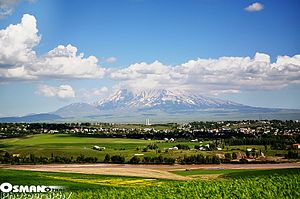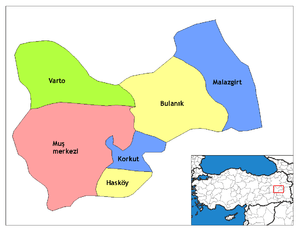Malazgirt
Malazgirt or Malâzgird (Kurdish: Melezgir,[3] Armenian: Մանազկերտ, romanized: Manazkert; Medieval Greek: Ματζιέρτη, romanized: Matziértē), historically known as Manzikert (Medieval Greek: Μαντζικέρτ), is a town in Muş Province in eastern Turkey, with a population of 23,697 (year 2000).
Malazgirt | |
|---|---|
 Malazgirt | |
| Coordinates: 39°08′52″N 42°32′39″E | |
| Country | |
| Province | Muş |
| Government | |
| • Mayor | Ahmet Kenan Türker (CHP) |
| • Kaymakam | Emre Yalçın |
| Area | |
| • District | 1,526.71 km2 (589.47 sq mi) |
| Population (2012)[2] | |
| • Urban | 21,733 |
| • District | 60,261 |
| • District density | 39/km2 (100/sq mi) |
| Post code | 49400 |
| Website | www.malazgirt.bel.tr |

History
Founding
The settlement dates to the Iron Age: according to Tadevos Hakobyan it was established during the reign of the Urartian king Menua (r. 810–785 BC).[4] The Armenian name Manazkert is supposedly shortened from Manavazkert (Armenian: Մանավազկերտ),[4] adopted in Greek as Μαντζικέρτ. The suffix -kert is frequently found in Armenian toponymy, meaning "built by". According to Movses Khorenatsi, Manzikert was founded by Manaz, one of the sons of Hayk, the legendary and eponymous patriarch and progenitor of the Armenians.[5] After the demise of Urartu it passed into the hands of successive regional kingdoms and empires.
Medieval
The lands around Manzikert belonged to the Manavazyans, an Armenian nakharar family which claimed descent from Manaz, until AD 333, when King Khosrov III Arshakuni of Armenia ordered that all members of the family be put to the sword.[4] He later awarded the lands to another family, the Aghbianosyans. Manzikert was a fortified town,[6] and served as an important trading center located in the canton of Apahunik' in the Turuberan province of the ancient Kingdom of Armenia. It also served as the capital of the Kaysite emirate from around 860 until 964.[7] Manzikert was the site of the Council of Manzikert in 726.
After the Armenian revolt of 771-772, the Abbasid government encouraged the migration of Arab tribes to the region, which resulted in the settling of Arab tribes near Malazgirt.[8] In 968, the Byzantine general Bardas Phokas captured Manzikert, which was incorporated into the Byzantine katepanate of Basprakania (Vaspurakan).[9] In 1054, the Seljuk Turks made an attempt to capture the city but were repulsed by the city's garrison under the command of Basil Apocapes.
The Battle of Manzikert was fought near the town in August 1071. In one of the most decisive defeats in Byzantine history, the Seljuk sultan Alp Arslan defeated and captured Emperor Romanus Diogenes, which led to the ethnic and religious transformation of Armenia and Anatolia and the establishment of the Seljuk Sultanate of Rum and later the Ottoman Empire and the Republic of Turkey. The Seljuks pillaged Manzikert itself, killed much of its population and burned the city to the ground.[4] It was successively part of Ahlatshahs (their rule was briefly interrupted by the Kingdom of Georgia), Ayyubids, Sultanate of Rum, Ilkhanids, Karakoyunlu, Timurids, Akkoyunlu and Safavids before Ottoman rule.
Modern
In April 1903, Manzikert was the location of an earthquake which has killed about 3500 people and demolished around 12.000 buildings.[10]
In 1915 Manzikert was part of Bitlis Vilayet and had a population of 5,000, the great majority of them Armenians.[4] The city's economy revolved around the cultivation of grain, trade and the production of handicrafts. There existed two Armenian churches, Yerek Khoran Surb Astvatsatsin (Three Altars Holy Mother of God) and Surb Gevork (St. George, called St. Sergius by H. F. B. Lynch),[11] and one Armenian school.
The current mayor of Malazgirt, elected in March 2019, is Ahmed Kenan Türker from the Republican Peoples' Party (CHP).[12] As District Governor of Malazgirt, Emre Yalçın was appointed.[13]
Notes
- "Area of regions (including lakes), km²". Regional Statistics Database. Turkish Statistical Institute. 2002. Retrieved 2013-03-05.
- "Population of province/district centers and towns/villages by districts - 2012". Address Based Population Registration System (ABPRS) Database. Turkish Statistical Institute. Retrieved 2013-02-27.
- Adem Avcıkıran (2009). Kürtçe Anamnez Anamneza bi Kurmancî (PDF) (in Turkish and Kurdish). p. 56. Retrieved 17 December 2019.
- (in Armenian) Hakobyan, Tadevos Kh. «Մանզիկերտ» [Manzikert]. Armenian Soviet Encyclopedia. Yerevan: Armenian Academy of Sciences, 1981, vol. 7, pp. 210-211.
- Movses Khorenatsi. History of the Armenians. Translation and commentary by Robert W. Thomson. Cambridge: Harvard University Press, 1978, I.12.
- Leiser, Gary. "Manzikert" in Medieval Islamic Civilization: An Encyclopedia. Josef W. Meri (ed.) London: Routledge, 2005, pp. 476-477, ISBN 0-415-96690-6.
- See Aram Ter-Ghevondyan, The Arab Emirates in Bagratid Armenia. Trans. Nina G. Garsoïan. Lisbon: Calouste Gulbenkian Foundation, 1976.
- Sinclair, T.A. (1989). Eastern Turkey: An Architectural & Archaeological Survey, Volume I. Pindar Press. p. 98. ISBN 9780907132325.
- Ter-Ghewondyan. Arab Emirates, p. 115.
- "Today in Earthquake History". earthquake.usgs.gov. Retrieved 2020-04-13.
- H. F. B. Lynch. Armenia, Travels and Studies. 2 vols. London: Longmans, 1901, vol. 2, pp. 270-73.
- "Turkey Local Election - Ahmet Kenan Türker - Republican People's Party Muş Malazgirt Mayor Candidates - March 31 Polls". www.anews.com.tr. Retrieved 2019-09-04.
- "T.C. Malazgirt Kaymakamlığı Resmi Web Sayfası". www.malazgirt.gov.tr. Retrieved 2019-11-10.
